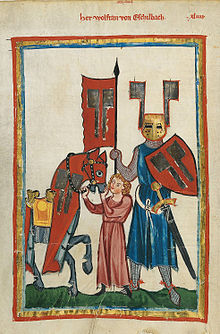Squire

Squire (also Knappe , Page ) said in the Middle Ages a ritterbürtiger young man (Edelknabe) which, when a knight learned the trade of arms and performed emergency services. Because he often carried the shield after his master , he was also called "shield bearer" ( late Latin : scutarius, scutiger, scutifer ) or (rather misleading :) "weapon (coat of arms) bearer" ( armed ). The term noble servant is also used rather misleadingly, but it correctly describes a full-fledged low-nobility cavalryman without knighthood.
middle Ages
Squires usually began their apprenticeship at the age of 7 as a page, in order to gain first experience as servants in courtly dealings and the nobility ceremonies. At the age of 14 they were solemnly raised to squires by the priest in front of the altar; for this they received a consecrated short sword .
The training now increasingly focused on learning the weapons trade. The squire now had to help his master put on his armor, maintain the weapons and supervise the care of the horses. He had to accompany him on campaigns and to tournaments , hand him arms and look after him in every respect. Equipped with his own shield, iron hat , short sword , mace or battle ax , he was sometimes allowed to take part in tournaments himself (especially in the mass fight, the Buhurt ). He was not allowed to fight only with a long sword and lance , the weapons reserved for knights.
The squire had to support his master in tournaments and battles . At the tournament, a squire led the warhorse after the knight, another wore a helmet, lance and shield (her French name Ecuyer, Schildträger, Schildknecht, squire). In battle the squire stayed behind his master to help him if he was wounded, to hand him another horse or lance, or to take the prisoners into safekeeping.
If the squire had reached the age of 21 and distinguished himself through courage and loyalty, he might receive the sword or the accolade .
Numerous miners, who for personal or economic reasons were not eligible for the accolade, served in the late Middle Ages as adult and fully equipped servants in the troops and tried to lead a knightly life. This class of society was generally no longer recognized as nobility in the early modern period.
Modern times

By the 17th century at the latest, the squire had survived as a result of advances in the military, and the squire became a "page" or "chamber boy", a young nobleman who performed minor services under the supervision of the chamberlain in the vicinity of a prince . The pages were educated at court and later officers or chamberlains themselves. As in the 18th century the formation of the male aristocratic young fully to boarding schools as cadet schools and Ritterakademien passed, this selected pupils presented in grades Oberprima and Selekta from as pages for special occasions days to Hofdiensten. A special honor was the temporary service of two cadets each as "body pages" of the emperor and the empress. As far as cadet training was concerned, the institution stayed in Germany until the November Revolution of 1918.
literature
- Rudolf Kilian Weigand: Half knights and servants. To categorize and illustrate marginalized social groups in Hugos von Trimberg's ›Renner‹. In: The presence of the Middle Ages in his manuscripts. Results of the Berlin conference in the Berlin State Library - Prussian Cultural Heritage, April 6th - 8th, 2000, ed. by H.-J. Schiewer and K. Stackmann, Tübingen, 2002, pp. 83-105.
Web links
- Article on the keyword "Page" in the encyclopedia by Johann Georg Krünitz (published from 1773-1858)
Individual proof
- ^ Berlin cadets as personal pages of the imperial couple . In: Friedrich von Senden : History of the Freiherrn von Senden and Freiherrn Schuler von Senden . Pro Business (manufactured on demand) ², Berlin 2010, ISBN 978-3-86805-628-0 , p. 258 f.
